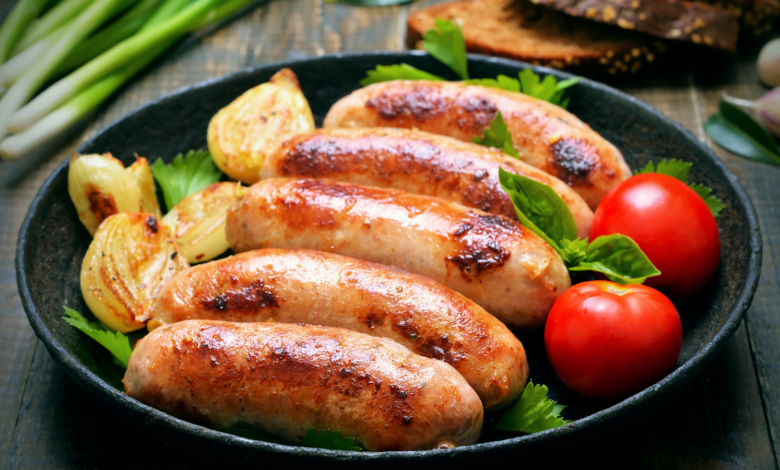Taste the Tradition: The Story Behind German Mustard and Sausages

In Germany, sausages and mustard are often paired together. This makes a delicious food fusion. The history behind these classic German foods is interesting. It shows Germany’s rich food heritage.
Sausage making has long been a cherished tradition in Germany. German yellow mustard is a staple condiment. It has evolved over time to complement the sausages. Pairing sausages with mustard allows you to savor the essence of German culinary traditions. These age-old traditions have endured over the years.
This article delves into the intriguing history. It celebrates mustard’s special role. Within the culinary heritage of German sausages.
A History of Sausages in Germany
Sausages have been part of German food for centuries. Some of the first written recipes for German sausages are from the 1300s. Different regions of Germany created their own sausage recipes using local ingredients.
By the 1500s, Germany was famous for its sausages. Germany’s cool weather, abundant livestock, and surplus of salt were good for curing sausages. German sausage laws also set their sausages apart. The sausages could only have meat, salt, and spices.
Many old techniques are still used to make German sausages today. Sausages are gently simmered in water first. Then they are cooled and hung to age. Traditional smoked sausages use natural wood chips. Authentic recipes rely on spices like caraway, nutmeg, and white pepper.
While hundreds of unique German sausages exist, these are among the most iconic:
- Bratwurst – Made from veal, pork, or beef. Seasoned with salt, pepper, and nutmeg.
- Weisswurst – A traditional Bavarian breakfast sausage made from minced veal and bacon.
- Currywurst – Pork sausage sliced and topped with ketchup mixed with curry powder.
- Bockwurst – A thicker veal and pork sausage flavored with chives.
- Knackwurst – Usually made from pork and beef with garlic.
Whether enjoyed in beer halls or at backyard grills, German sausages continue to hold a special place in the culture today.
The following chart shows sausage consumption in Germany over a 5-year period.
Data Source: German Meat Association
A Closer Look at German Mustard
In Germany, a sausage is not complete without a schmear of mustard. The origins of this quintessential condiment are rooted in German history.
Archaeological evidence suggests mustard seeds were first cultivated in Europe as early as 3,000 BC. By the 13th century, mustard had become an established ingredient across Germany. In the early days, mustard-making involved crushing the seeds into a paste using a mortar and pestle.
The city of Düsseldorf became renowned as the mustard capital of the world beginning in the 1600s. Düsseldorf mustard makers were the first to create the smooth, spreadable style of mustard still preferred in Germany today. Their secret was slowly adding vinegar to ground mustard seeds to develop the signature flavor and texture.
By the 19th century, Germany had cemented its reputation as “the land of mustard.” Regional mustard traditions also flourished. In Bavaria, sweet mustard seasoned with horseradish was preferred. In the Rhineland, mustard blended with herbs and spices grew popular. And in Berlin, hot mustard spiked with chili peppers became a local specialty.
Today, Germans still rank among the world’s largest consumers of mustard. Some popular varieties of mustard include sweet hot Bavarian mustard and classic Düsseldorf-style mustard. These mustards are frequently served alongside zesty stoneground varieties infused with ingredients such as beer and figs.
Why Mustard and Sausages Are Meant to Be
Mustard and sausages are intertwined in German food culture for good reason. The balance of flavors and textures makes them an unbeatable combination.
The tanginess of mustard perfectly offsets the richness of fatty sausages. Mustard’s subtle heat also cuts through the spices in seasoned sausages like bratwurst and bockwurst. And grainy-style mustards provide texture to complement smooth, finely ground sausages and wieners.
From street food to Oktoberfest, mustard brings out the best in German sausages. A smear of classic yellow mustard is still the default pairing. But seasonal mustards like spring’s wild garlic mustard or autumn’s pumpkin seed mustard also pair wonderfully.
Beyond flavor, the heritage behind both mustard and sausages is intrinsically German. Their long history and regional diversity are part of what makes the duo so special.
| Aspect | German Mustard | German Sausages |
| Ingredients | Sour mash, vinegar, white wine, unique spices | Meat, spices, casings |
| Flavor Profile | From hot to sweet, versatile | Varied, includes bratwurst, weisswurst, and more |
| Culinary Role | Condiment, flavor enhancer | Main dish or appetizer |
| Regional Varieties | Different mustard styles by region | Regional sausage specialties |
| Culinary Traditions | Essential for sausages | Key ingredient in various dishes |
| Historical Significance | Evolved over time | Long-standing tradition |
| Pairings | Often served with sausages | Diverse culinary combinations |
| Common Uses | Hot dogs, sausages, pretzels | Grilled, boiled, or fried |
| Cultural Impact | Part of German food culture | Iconic in German cuisine |
Pairing Perfection: Mustard Meets Sausage
Germans carefully match mustards to balance and elevate different sausages and meats. Some classic pairings include:
Bratwurst + Mittelscharf – The pleasant heat accentuates the flavor of grilled pork sausage.
Weisswurst + Süß – The sweetness contrasts and cuts through the creamy veal in this white sausage.
Bockwurst + Düsseldorf – The strong, hot tang of this mustard complements the subtle beer-infused flavors.
Blutwurst + Born – The fruity tones balance the intense iron-rich taste of the blood sausage.
Sauerbraten + Süß – The sweetness mellows the tang of this pot-roasted marinated meat dish.
In addition to traditional pairings, modern German chefs incorporate mustard in creative ways too. These include:
- Mustard-infused sausage casings that add a flavorful burst when bitten into.
- Mixing whole grain mustard into sausage meat before stuffing for layers of flavor.
- Beer-mustard reduction sauces that bring tangy depth to grilled sausages.
- Coating sausages in mustard seeds before roasting to form an outer crust.
Fresh trends in mustard pairings continue to surface. These contemporary pairings coexist with the time-honored combinations that have upheld centuries of German sausage wisdom.
Celebrating Tradition by the Bite
From old-world butcher shops to modern beer halls, the tradition of German sausages and mustards lives on. There are many delicious ways to enjoy this heritage at home as well:
- Grill an assortment of classic sausages and serve with an array of mustards.
- Make a sampler plate of Beerwurst, Bratwurst, and Knackwurst paired with Düsseldorf, stone ground, and hot mustards.
- Mix up meats by swapping in landjaeger or weisswurst sausages.
- Pair Currywurst sausage with curry ketchup mustard.
- Spread mustard on a freshly baked pretzel and top with a sliced frankfurter.
- For breakfast, dip Weisswurst sausages in sweet German mustard.
Regardless of how they are served, German sausages and mustard are most delightful when enjoyed together. Each bite commemorates centuries of tradition!
FAQs
Why are there so many varieties of sausages in Germany?
Germany’s sausage diversity stems from its distinct regional cultures. Local areas specialized recipes based on locally available meat, spices, and flavor preferences. These distinctive styles were safeguarded by guilds of sausage makers. Today, adherence to Germany’s sausage purity law, or Wurstgesetz ensures quality is maintained.
How is German mustard different from global varieties?
German mustards are unique with sour mash, famous regional vinegar, white wine, and special spices like crushed fruit kernels. They range from very hot to sweetly mild. So they are an essential part of German food, not just a random condiment.
What are the traditional occasions for enjoying sausages and mustard?
Beyond daily meals, sausages and mustard are stars of festivals like Oktoberfest. They also feature in street food like the iconic currywurst. And signatures like the Weisswurstfrühstück (white sausage breakfast) uphold tradition. From football games to Christmas markets, German sausages with mustard are a cherished treat.
Share the Tradition
German mustards and sausages are the perfect way to share a little European culture and cuisine. Try some classic flavor pairings or introduce friends to new regional specialties.
Just be sure to provide plenty of mustard – it’s essential for enjoying German sausages the authentic way! Bring an appetite, mix the mustard, and taste this living history.



